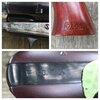I wonder though, how strong are these revolvers? Will they hold up to hundreds of rounds of .357 mag? I would certainly shoot more .38 special through it. But a lot of times they are listed as being chambered in "38spl/357mag". That just makes me question how strong it is. Like, is it mainly just for CAS, or is quite capable?
Howdy
This question gets asked a lot.
The 357 Magnum cartridge was developed by Smith and Wesson in 1935. That same year it was first chambered in the Colt Single Action Army. That was a long time ago, plenty of time for any problems to have arisen.
The SAA is a large revolver. There is plenty of steel surrounding the chambers to contain the pressure generated by the 357 Magnum cartridge.
Here is a photo that will help tell the story. On the left is a 357 Magnum cylinder from a Ruger New Vaquero. On the right is a 357 Magnum cylinder from a Smith and Wesson Model 28.
The S&W cylinder is from an N frame revolver, the large size that was first used for the 357 Magnum cartridge in 1935. While not a Colt, the Ruger New Vaquero cylinder has dimensions very similar to a Colt.
Notice how much steel there is between chambers. Both of these cylinders are plenty strong enough for standard 357 Magnum loads, as are the cylinders of a Colt or Italian replica of the Colt.

As has been stated, Cimarron is not a manufacturer, they import Italian revolvers made by Pietta and Uberti.
So the only practical concerns shooting 357, or should I say, 357 pressures, in a single action revolver would be if it were made in a time when metallurgy was dubious.
In 1935 Colt was using fine grain, high tensile strength ordnance steel for their 357 Magnum cylinders. Plenty strong enough for the cartridge.
On the other hand, the cartridge is not the thing that tends to wear out revolvers. On a single action, I would imagine the first things to go would be the hand or the cylinder stop or the notches. The maker has to be clever to harden each of these elements in a practical way. We want the cylinder ratchet and notches to be very hard so they don't wear, but we don't want the cylinder hardened like glass so that it shatters upon failure. Because the cylinder can't be hardened to the point of brittleness, it necessarily has some softness. It would be an easy thing to make a hand and cylinder stop that was brutally hard and never exhibited any wear, but they would dig the hell out of the softer cylinder. So what to do? Perhaps a clever maker could differentially harden the cylinder and ratchet, but not likely the notches also. Would we rather replace a worn hand and cylinder stop or replace a worn cylinder?
I have Colts that are over 100 years old. The cylinder ratchets and notches are fine, they do not wear out.
The biggest weakness of the Colt design was the leaf type springs they used. Leaf springs can become work hardened and can break. The two most common failures in a Colt or Colt type revolver are the split trigger/bolt spring and the hand spring.
These broken parts are from a 2nd Generation Colt Single Action Army. The part at the top is the trigger/bolt spring. That is the way they tend to break, right at the base of one of the arms.
The other part is the bolt. The bolt on a Colt or Italian replica is made of spring steel and one of the arms flexes every time hammer cam flashes by it as the hammer falls. This arm failed. Notice it broke right at the weakest point, where the metal is the thinnest around the hole.

It is quite common for the split trigger/bolt spring to break in the old Colt design. I'm not saying they will break soon, as I said the parts in my 100 year old Colts are still working fine. In my experience the bolt breaking like that is unusual. The split spring and the hand spring breaking is not. Also, I have never heard of the leaf type mainspring (hammer spring) in a Colt breaking.
These are the lockwork parts of a Colt. The handspring is the curved spring attached to the hand. When this spring breaks it generally breaks at the sharp curve at the bottom where it is pressed into the hand.

Because of this, most of the Italian replicas being imported today have substituted a coil spring similar to what Ruger uses for their hand springs, so that problem with import hand springs does not exist anymore.
Long, long ago, Ruger substituted coil springs for all the springs in their revolvers, I have never heard of a Ruger coil spring breaking.
Again, I am not saying that an old fashioned leaf spring is going to fail tomorrow, they usually work for many years. However they can break.
I substituted an after market wire spring for the normal split trigger/bolt spring in this Colt a long time ago. No, this is not the Colt that suffered the broken springs, that one has had traditional parts reinstalled.

P.S. I have no experience with the Heritage revolvers or Bounty Hunters, so I cannot speak for them.

















